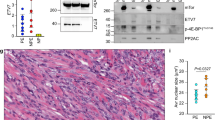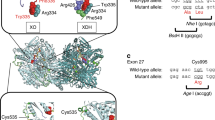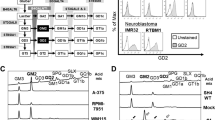Abstract
Biologically active membrane gangliosides, expressed and released by many human tumors, are hypothesized to significantly impact tumor progression. Lack of a model of complete and specific tumor ganglioside depletion in vivo, however, has hampered elucidation of their role. Here, we report the creation of a novel, stable, genetically induced tumor cell system resulting in specific and complete blockade of ganglioside synthesis. Wild-type (WT) and GM3 synthase/GM2 synthase double knockout (DKO) murine embryonic fibroblasts were transformed using amphotropic retrovirus-transduced oncogenes (pBABE-c-MycT58A+H-RasG12V). The transformed cells, WTt and DKOt respectively, evidenced comparable integrated copy numbers and oncogene expression. Ganglioside synthesis was completely blocked in the DKOt cells, importantly without triggering an alternate pathway of ganglioside synthesis. Ganglioside depletion (to <0.5 nmol/107 cells from 9 to 11 nmol/107 WTt or untransfected normal fibroblasts) did not adversely affect cell proliferation kinetics but did reduce cell migration on fibronectin-coated wells, consistent with our previous observations in ganglioside-depleted normal human fibroblasts. Strikingly, despite similar oncogene expression and growth kinetics, DKOt cells evidenced significantly impaired tumor growth in syngeneic immunocompetent mice, underscoring the pivotal role of tumor cell gangliosides and providing an ideal system for probing their mechanisms of action in vivo.
This is a preview of subscription content, access via your institution
Access options
Subscribe to this journal
Receive 50 print issues and online access
$259.00 per year
only $5.18 per issue
Buy this article
- Purchase on Springer Link
- Instant access to full article PDF
Prices may be subject to local taxes which are calculated during checkout






Similar content being viewed by others
References
Allende ML, Proia RL . (2002). Lubricating cell signaling pathways with gangliosides. Curr Opin Struct Biol 12: 587–592.
Buggins AG, Milojkovic D, Arno MJ, Lea NC, Mufti GJ, Thomas NS et al. (2001). Microenvironment produced by acute myeloid leukemia cells prevents T cell activation and proliferation by inhibition of NF-kappaB, c-Myc, and pRb pathways. J Immunol 167: 6021–6030.
Cazet A, Groux-Degroote S, Teylaert B, Kwon KM, Lehoux S, Slomianny C et al. (2009). G(D3) synthase overexpression enhances proliferation and migration of MDA-MB-231 breast cancer cells. Biol Chem 390: 601–609.
Deng W, Li R, Guerrera M, Liu Y, Ladisch S . (2002). Transfection of glucosylceramide synthase antisense inhibits mouse melanoma formation. Glycobiology 12: 145–152.
Floutsis G, Ulsh L, Ladisch S . (1989). Immunosuppressive activity of human neuroblastoma tumor gangliosides. Int J Cancer 43: 6–9.
Hakomori S . (1973). Glycolipids of tumor cell membrane. Adv Cancer Res 18: 265–315.
Hakomori S . (1996). Tumor malignancy defined by aberrant glycosylation and sphingo(glyco)lipid metabolism. Cancer Res 56: 5309–5318.
Hyuga S, Yamagata S, Takatsu Y, Hyuga M, Nakanishi H, Furukawa K et al. (1999). Suppression by ganglioside GD1A of migration capability, adhesion to vitronectin and metastatic potential of highly metastatic FBJ-LL cells. Int J Cancer 83: 685–691.
Inokuchi J, Momosaki K, Shimeno H, Nagamatsu A, Radin NS . (1989). Effects of D-threo-PDMP, an inhibitor of glucosylceramide synthetase, on expression of cell surface glycolipid antigen and binding to adhesive proteins by B16 melanoma cells. J Cell Physiol 141: 573–583.
Jeyakumar M, Butters TD, Dwek RA, Platt FM . (2002). Glycosphingolipid lysosomal storage diseases: therapy and pathogenesis. Neuropathol Appl Neurobiol 28: 343–357.
Kendall SD, Linardic CM, Adam SJ, Counter CM . (2005). A network of genetic events sufficient to convert normal human cells to a tumorigenic state. Cancer Res 65: 9824–9828.
Ladisch S . (2003). The role of tumor gangliosides in the immune dysfunction of cancer. In: Finke JH and Bukowski RM (eds) Current Clinical Oncology: Cancer Immunotherapy at the Crossroads: How Tumors Evade Immunity and What Can Be Done. Humana Press, Totowa, NJ, pp 145–156.
Ladisch S, Gillard B . (1985). A solvent partition method for microscale ganglioside purification. Anal Biochem 146: 220–231.
Ladisch S, Gillard B, Wong C, Ulsh L . (1983). Shedding and immunoregulatory activity of YAC-1 lymphoma cell gangliosides. Cancer Res 43: 3808–3813.
Ladisch S, Kitada S, Hays EF . (1987). Gangliosides shed by tumor cells enhance tumor formation in mice. J Clin Invest 79: 1879–1882.
Lavie Y, Cao H, Bursten SL, Giuliano AE, Cabot MC . (1996). Accumulation of glucosylceramides in multidrug-resistant cancer cells. J Biol Chem 271: 19530–19536.
Ledeen RW . (1978). Ganglioside structures and distribution: are they localized at the nerve ending? J Supramol Struct 8: 1–17.
Li R, Liu Y, Ladisch S . (2001). Enhancement of epidermal growth factor signaling and activation of SRC kinase by gangliosides. J Biol Chem 276: 42782–42792.
Li RX, Ladisch S . (1991). Shedding of human neuroblastoma gangliosides. Biochim Biophys Acta 1083: 57–64.
Liu Y, Li R, Ladisch S . (2004). Exogenous ganglioside GD1a enhances epidermal growth factor receptor binding and dimerization. J Biol Chem 279: 36481–36489.
Liu Y, McCarthy J, Ladisch S . (2006). Membrane ganglioside enrichment lowers the threshold for vascular endothelial cell angiogenic signaling. Cancer Res 66: 10408–10414.
Liu Y, Su Y, Wiznitzer M, Epifano O, Ladisch S . (2008). Ganglioside depletion and EGF responses of human GM3 synthase-deficient fibroblasts. Glycobiology 18: 593–601.
Mitsuzuka K, Handa K, Satoh M, Arai Y, Hakomori S . (2005). A specific microdomain (‘glycosynapse 3’) controls phenotypic conversion and reversion of bladder cancer cells through GM3-mediated interaction of alpha3beta1 integrin with CD9. J Biol Chem 280: 35545–35553.
Rani CS, Abe A, Chang Y, Rosenzweig N, Saltiel AR, Radin NS et al. (1995). Cell cycle arrest induced by an inhibitor of glucosylceramide synthase. Correlation with cyclin-dependent kinases. J Biol Chem 270: 2859–2867.
Regina Todeschini A, Hakomori SI . (2008). Functional role of glycosphingolipids and gangliosides in control of cell adhesion, motility, and growth, through glycosynaptic microdomains. Biochim Biophys Acta 1780: 421–433.
Ronnov-Jessen L, Villadsen R, Edwards JC, Petersen OW . (2002). Differential expression of a chloride intracellular channel gene, CLIC4, in transforming growth factor-beta1-mediated conversion of fibroblasts to myofibroblasts. Am J Pathol 161: 471–480.
Saha S, Mohanty KC, Mallick P . (2005). Gangliosides enhance migration of mouse B16-melanoma cells through artificial basement membrane alone or in presence of laminin or fibronectin. Indian J Exp Biol 43: 1130–1138.
Schenck M, Carpinteiro A, Grassme H, Lang F, Gulbins E . (2007). Ceramide: physiological and pathophysiological aspects. Arch Biochem Biophys 462: 171–175.
Shevchuk NA, Hathout Y, Epifano O, Su Y, Liu Y, Sutherland M et al. (2007). Alteration of ganglioside synthesis by GM3 synthase knockout in murine embryonic fibroblasts. Biochim Biophys Acta 1771: 1226–1234.
Shurin GV, Shurin MR, Bykovskaia S, Shogan J, Lotze MT, Barksdale Jr EM . (2001). Neuroblastoma-derived gangliosides inhibit dendritic cell generation and function. Cancer Res 61: 363–369.
Simpson MA, Cross H, Proukakis C, Priestman DA, Neville DC, Reinkensmeier G et al. (2004). Infantile-onset symptomatic epilepsy syndrome caused by a homozygous loss-of-function mutation of GM3 synthase. Nat Genet 36: 1225–1229.
Thompson TC, Southgate J, Kitchener G, Land H . (1989). Multistage carcinogenesis induced by ras and myc oncogenes in a reconstituted organ. Cell 56: 917–930.
Uzzo RG, Rayman P, Kolenko V, Clark PE, Cathcart MK, Bloom T et al. (1999). Renal cell carcinoma-derived gangliosides suppress nuclear factor-kappaB activation in T cells. J Clin Invest 104: 769–776.
Valentino L, Moss T, Olson E, Wang HJ, Elashoff R, Ladisch S . (1990). Shed tumor gangliosides and progression of human neuroblastoma. Blood 75: 1564–1567.
van Engeland M, Ramaekers FC, Schutte B, Reutelingsperger CP . (1996). A novel assay to measure loss of plasma membrane asymmetry during apoptosis of adherent cells in culture. Cytometry 24: 131–139.
Villar J, Arenas MI, MacCarthy CM, Blanquez MJ, Tirado OM, Notario V . (2007). PCPH/ENTPD5 expression enhances the invasiveness of human prostate cancer cells by a protein kinase C delta-dependent mechanism. Cancer Res 67: 10859–10868.
Yamashita T, Hashiramoto A, Haluzik M, Mizukami H, Beck S, Norton A et al. (2003). Enhanced insulin sensitivity in mice lacking ganglioside GM3. Proc Natl Acad Sci USA 100: 3445–3449.
Yamashita T, Wu YP, Sandhoff R, Werth N, Mizukami H, Ellis JM et al. (2005). Interruption of ganglioside synthesis produces central nervous system degeneration and altered axon-glial interactions. Proc Natl Acad Sci USA 102: 2725–2730.
Acknowledgements
We thank Rick Proia for the GM3S mice. This work was supported by NIH grants CA61010 and CA42361 to SL, CA64472 to VN, and GM62116 to the Consortium for Functional Glycomics.
Author information
Authors and Affiliations
Corresponding author
Ethics declarations
Competing interests
The authors declare no conflict of interest.
Additional information
Supplementary Information accompanies the paper on the Oncogene website
Rights and permissions
About this article
Cite this article
Liu, Y., Yan, S., Wondimu, A. et al. Ganglioside synthase knockout in oncogene-transformed fibroblasts depletes gangliosides and impairs tumor growth. Oncogene 29, 3297–3306 (2010). https://doi.org/10.1038/onc.2010.85
Received:
Revised:
Accepted:
Published:
Issue Date:
DOI: https://doi.org/10.1038/onc.2010.85
Keywords
This article is cited by
-
B4GALNT1 induces angiogenesis, anchorage independence growth and motility, and promotes tumorigenesis in melanoma by induction of ganglioside GM2/GD2
Scientific Reports (2020)
-
Generation and characterization of a IgG monoclonal antibody specific for GM3 (NeuGc) ganglioside by immunizing β3Gn-T5 knockout mice
Scientific Reports (2018)
-
TALEN mediated targeted editing of GM2/GD2-synthase gene modulates anchorage independent growth by reducing anoikis resistance in mouse tumor cells
Scientific Reports (2015)
-
Tumor gangliosides accelerate murine tumor angiogenesis
Angiogenesis (2014)



